Any joinery starts with a blank. And this workpiece must be of decent quality: even, smooth and precise. For the processing of lumber, planing and thicknessing machines are used, which, working together, allow to significantly simplify and speed up the work of the joiner, and at the same time to improve the accuracy and quality of his work. In this article, we will tell you how to choose a thicknessing machine and bring to your attention the Top 5 thicknessers from different manufacturers.
CONTENT
- 1 What is a thicknessing machine and how does it differ from a planer
- 2 What to look for when choosing a thicknessing machine
- 3 Rating of planers
What is a thicknessing machine and how does it differ from a planer
A thickness gauge is a marking tool with which parallel lines are drawn and the drawings are transferred to the workpiece. The thicknessing machine, which is also often called the thicknessing machine in the common people, allows you to remove the top layer of wood from the workpieces with high accuracy to give them the required thickness and smoothness. To do it manually is difficult, long and tedious - you need firm hands, keen eyes and great accuracy. But the machine will do everything for the carpenter, you just need to choose the desired thickness of the finished product.
This whole system is not too complicated. The rollers press the board against a metal table and, rotating, roll it over it, and the rotating knife shaft removes the top layer from the lumber, calibrating the board to the same thickness.
The planer is very similar to the thicknessing machine, but these devices are complementary, not interchangeable. The planer is designed for leveling the workpieces, and the thicknessing machine - for planing them in thickness. If you load a curved board into the thickness gauge, then after processing it will remain a curve, even if it becomes the same thickness along its entire length. So, during processing, the lumber is first leveled on a jointer, and then calibrated with a thickness gauge.
There are also machines that combine the functions of planers and planers, but this is a topic for a separate material.
What to look for when choosing a thicknessing machine
Engine power. The higher it is, the more productive the machine is and the more it consumes electricity. Usually it fluctuates between 1500-2000 watts.
Processed sides. Usually the planer works with only one side of the part - the top, however planer-thicknessing machines work with top and bottom edges at the same time, and professional models can even be versatile, but this is a rare phenomenon.
Shaft rotation speed. As a rule, it fluctuates between 8000-10000 rpm. The higher the maximum rotation speed, the more capricious material the machine can work with.
Removal depth. It shows how thick the layer can be removed by the machine from the board in one pass. As a rule, manufacturers indicate the maximum removal thickness of 2-3 mm, but this result is possible only when using sufficiently narrow workpieces. If you go too deep into a wide part, the motor simply cannot turn the cutterblock and the work will stop.
Workpiece dimensions. Thicknessers are usually capable of processing parts with a thickness of 5-6 to 150 mm. Thinner workpieces would deform too much and turn into chips, but thicker ones would make the machine too bulky. The planing width is usually 300-330 mm.
Auto feed speed. All thicknessing machines are equipped with an automatic feeding system: rollers, which press the workpiece to the table, and move it. Typically, the speed of movement of the part inside the machine is 4 to 9 meters per minute.
Knife type. The knives in the cutterblock can be disposable and re-sharpened. Disposable ones usually have double-sided sharpening: when one side is blunt, the knife must be turned over to the other: when it becomes blunt, the working tool must be changed. Reusable knives, after they lose their sharpness, just need to be sharpened again. The first option is simpler and more convenient, however, replacement knives are quite expensive, and besides, it is not always possible to find a knife of a suitable model. Reusable knives are cheaper to operate and can last for many years without needing to be replaced.
Number of knives. Typically a cutterblock contains two knives positioned opposite each other. Shafts with three knives are less common.
Roller material. Simpler planes are often equipped with rollers made of plain black rubber: they can slip on the workpiece, and if it slips, then leave black marks on it. Polyurethane rollers do not leave marks on the parts, therefore it is preferable to rubber ones. Embossed metal rollers exclude slippage and do not paint the boards, however, they can leave marks on the workpieces when pressed, which remain even after processing.
Marking system. This is also worth paying attention to when buying: thicknessing machines can be equipped with millimeter or inch type markings. If you forget about this, then you have to translate fractions of an inch into fractions of a meter in your head, and this is another chance to make a mistake.
Chip receiver. So that the shavings do not fill up everything around, planers are equipped with special catchers that are connected to the dust removal system. On the one hand, this keeps the workshop clean, on the other hand, the chip holders are constantly clogged up, so it's worth keeping an eye on.
Professional and household thicknesser machines. This division is rather arbitrary and there are no fundamental differences between professional, semi-professional and household models. However, models for specialists are usually more productive, more reliable and designed for long-term continuous operation, but they are much more expensive than household models.
Rating of planers
1. Makita 2012 NB
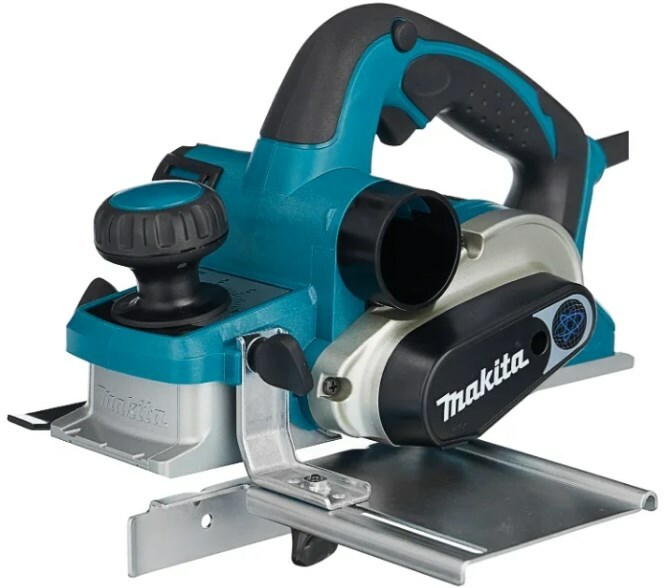
Thicknesser from a popular Japanese brand. The model is equipped with an electric motor with a power of 1650 watts, capable of delivering 8500 revolutions of the knife shaft per minute. The maximum planing width is 304 mm and the depth is 3 mm. The set includes a wrench and socket wrench for setting and adjusting, as well as a branch pipe for removing chips. The device is designed for at least 8 hours of continuous operation, which allows it to be classified as professional. The planer shaft uses easily replaceable, re-sharpened double-sided blades. The device is distinguished by very quiet operation: the noise level does not exceed 83 dB. The machine costs, of course, a little expensive - 45,000 rubles - but it is definitely worth it.
Price:₽ 45 000
Electric planer Makita KP0810C
2. Metabo DH 330 0200033000
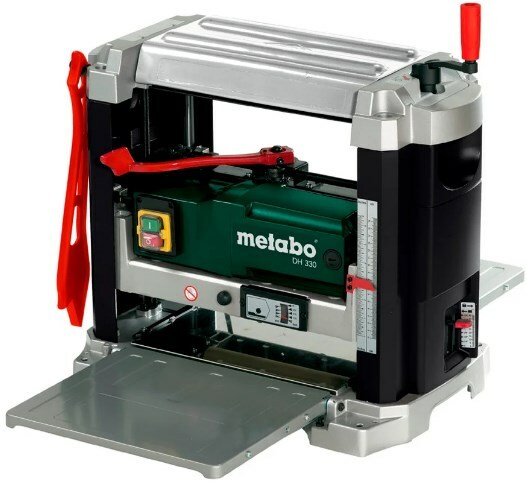
This surface gauge is a little cheaper than the previous one - they ask for about 40,000 rubles for it - but in terms of reliability and functionality it is almost not inferior to it, and in some possibilities even surpasses it. A rather powerful 1800 watt electric motor is installed here, which supports the rotation of the shaft at a speed of up to 9800 rpm. The knife shaft with a diameter of 47 mm is equipped with two reversible knives. The feed rate of the workpieces is 7 meters per minute. Maximum planing width - 330 mm, depth - 3 mm. The machine is distinguished by its convenient operation and functions of protection against restarting and blocking of the planer mechanism. The set includes a branch pipe for collecting shavings.
Price:₽ 39 999
Metabo DH 330 0200033000
3. Elitech STR 1833E
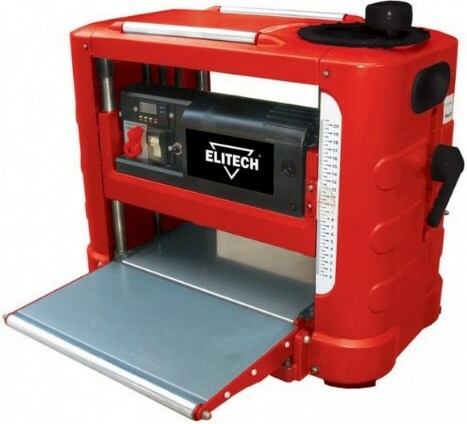
For this thicknessing machine they ask 25,000 - 31,500 rubles, but its capabilities will be enough for a model that is one and a half times more expensive. The case is protected from dust and moisture according to the IP21 standard: of course, it is not worth heating it, but in a wet and dusty workshop it will work without problems, without losing reliability. The minimum thickness of the workpiece for processing is 5 mm, the maximum is 150 mm. The planing depth is 3 mm and the maximum working width is 330 mm. The parts feed speed is 4 to 6 meters per minute. The 1,800 watt motor supports the blade shaft speed up to 9,000 rpm. Dust extraction is provided with fastening on two screws.
Price:₽ 31 459
Elitech STR 1833E
4. Jet Jwp-12 10000840m
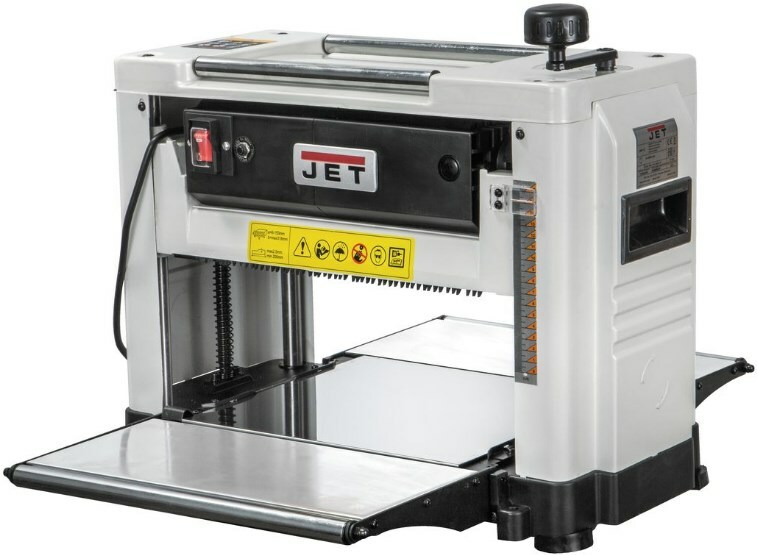
This portable flat bed thicknessing machine is equipped with a powerful and reliable but lightweight 1800 watt collector motor. This is enough to handle workpieces up to 318 mm wide and 6 mm to 153 mm thick at 9000 rpm. The maximum planing depth is 2.5 mm (when working at full width, this parameter is 1 mm). Overheating protection is provided. The set includes two sets of interchangeable knives and assembly tools. A very compact but productive machine at the price of 26,500 rubles, which is perfect for a small home workshop.
Price:₽ 26 500
Jet Jwp-12 10000840m
5. Enkor Corvette-21 90210
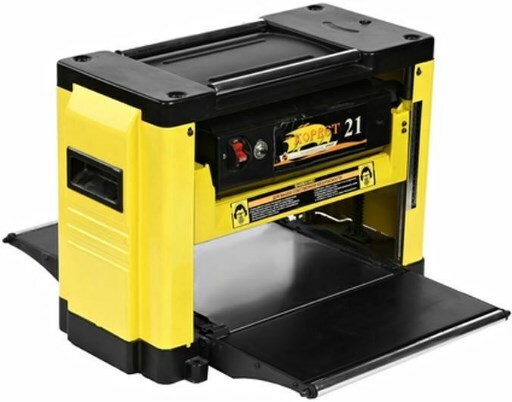
Inexpensive compact model from a domestic brand, which costs only a little more than 19,000 rubles. One of the most affordable devices in its class on the market. A 1.5 kW electric motor is enough to rotate the knife shaft at 8000 rpm. The feed speed of the workpiece is 8 meters per minute. The maximum planing depth is 2.5 mm, the workpiece width is 318 mm, and the thickness is 153 mm. The functionality of this machine is quite enough to meet the needs of a small home workshop. The machine fulfills its price in full, but you should not count on anything more, including professional use.
Price:₽ 18 990
Enkor Corvette 21 90210
